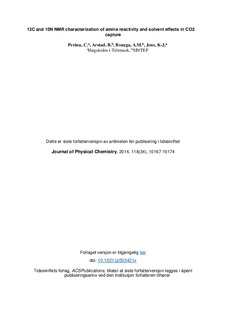13C and 15N NMR characterization of amine reactivity and solvent effects in CO2 capture
Journal article, Peer reviewed
Accepted version
Permanent lenke
http://hdl.handle.net/11250/2455361Utgivelsesdato
2014Metadata
Vis full innførselSamlinger
Sammendrag
Factors influencing the reactivity of selected amine absorbents for carbon dioxide (CO2) capture, in terms of the tendency to form amine carbamate, have been studied. Four linear primary alkanolamines at varying chain lengths (MEA, 3A1P, 4A1B, and 5A1P), two primary amines with different substituents in the β-position to the nitrogen (1A2P and ISOB), a secondary alkanolamine (DEA), and a sterically hindered primary amine (AMP) were investigated. The relationship between the 15N NMR data of aqueous amines and their ability to form carbamate, as determined at equilibrium by quantitative 13C NMR experiments, was analyzed, taking into account structural–chemical properties. For all the amines, the 15N chemical shifts fairly reflected the observed reactivity for carbamate formation. In addition to being a useful tool for the investigation of amine reactivity, 15N NMR data clearly provided evidence of the importance of solvent effects for the understanding of chemical dynamics in CO2 capture by aqueous amine absorbents.
